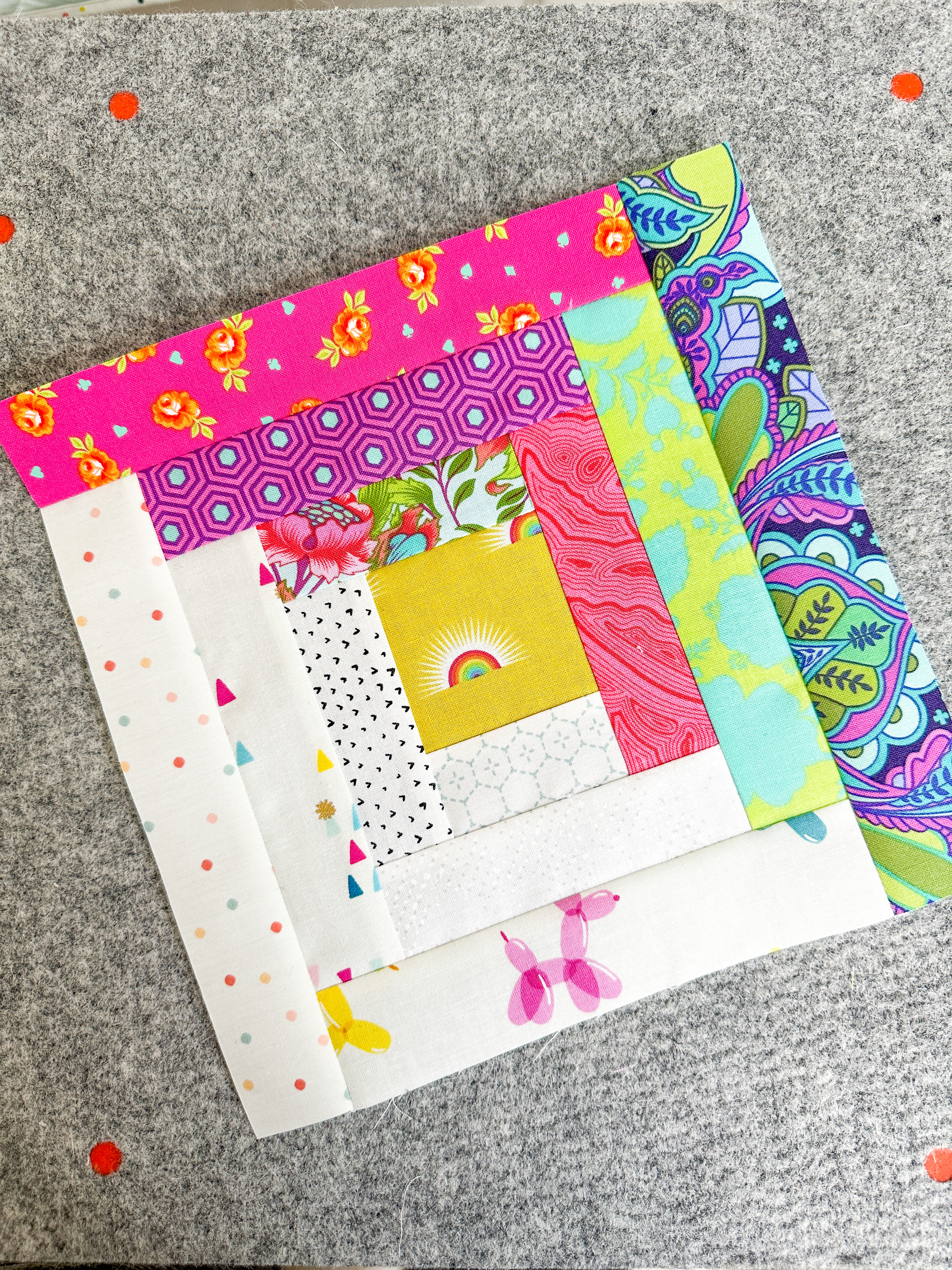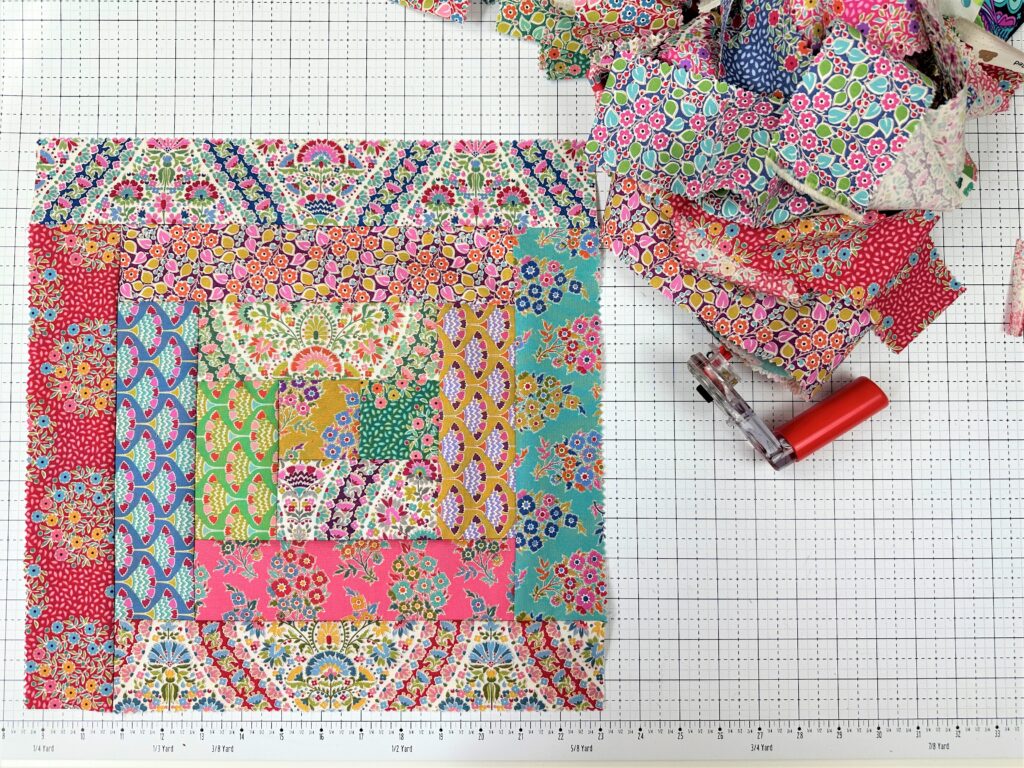Are you looking for a new challenge in quilting that is both fun and rewarding? Well, look no further! The log cabin quilt block is a timeless classic that can be made with various fabrics, colors and sizes to create an eye-catching effect.
In this tutorial we will discuss how to make a log cabin quilt block from a 2 1/2″ jelly roll pre cut – the perfect project for beginner quilters who want to add some vintage charm to their next project. Let’s jump into the tutorial!
WHAT IS A JELLY ROLL?
So before we can begin the tutorial about using a jelly roll, let’s talk about what that is and how you can use this tutorial without one too! A jelly roll pre-cut is a roll of pre-cut strips from a coordinated fabric collection. The rolls measure 2 1/2″ in width and are usually made up of 30 or 40 strips. They are cut from selvage to selvage of a bolt of fabric, so the length of each strip will vary depending on the manufacturer, usually 40″ to 42″ long.

You may be wondering….so do I HAVE to have a jelly roll for this project? NO, not at all! You can use fat quarters, yardage or your scraps. Simply cut your strips at 2 1/2″ wide by the length needed (see the cutting instructions below).
SUPPLIES NEEDED:
-Sewing machine/needles/thread (I use Aurifil 50 weight thread for all of my piecing)
-Fabric (I am using a jelly roll of Tilda Fabrics Pie in the Sky Collection but as mentioned, you can use anything!)
-Rotary cutter and cutting mat
IMPORTANT LOG CABIN MAKING TIPS
*An accurate ¼” seam is key – if you need help with this, I have linked a video in the description to help you achieve an accurate ¼” seam in your sewing. This is important, because we are piecing several strips, an incorrect seam allowance can really impact your block size and minor errors add up to large ones.
*As you are maintaining your proper seam allowance, ensure that you are evenly sewing your strips to the next. Constructing a log cabin block can get off quickly and then you end up with a crooked or wonky block. Best suggestions for success are to check your seam allowances, measure sections after being sewn together and trim as you go if needed.
EXTRA TIP: Do not prewash jelly roll strips in a washing machine. They can stretch out of shape and fray! Ask me how I know! If you do wish to pre-wash, then hand wash gently and hang to air dry. But, also consider that you should VERY carefully iron these as well. Ironing can stretch the fabric as well. Basically, I highly suggest that you avoid prewashing.

PLAN YOUR DESIGN/LAYOUT
A traditional log cabin block alternates the strips on one side of the block from lighter to darker, creating a diagonal division in the finished block.

This also creates a secondary pattern with multiple blocks. Take a look at these mock ups that show you how the color variations in the block can create secondary designs. These are just 2 basic layouts/colors, there are so many more possibilities!
Aren’t they great! In this tutorial, since we are using a jelly roll, we are making a more scrappy look, using various colors and prints. You can do the same variations even if you aren’t using a jelly roll.
CUTTING & ORGANIZING YOUR FABRIC
After your initial planning of your design and fabrics, you will cut your square and strips and organize them in piles by size with your labels.
For (1) 14” finished block, you will need the following cut pieces:
(2) 2 ½” x 2 ½” squares
(2) 2 ½” x 4 ½” rectangles
(2) 2 ½” x 6 ½” rectangles
(2) 2 ½” x 8 ½” rectangles
(2) 2 ½” x 10 ½” rectangles
(2) 2 ½” x 12 ½” rectangles
(1) 2 ½” x 14 ½” rectangle
Remember, these cutting instructions are just a guide! You can make a log cabin block with any size squares and strips and make the block as small or as large as you’d like!
I find that it’s easier to label your fabric strips. This allows for easy organization and construction at your sewing machine. Just take your time and remember, go in order in a clock wise direction! I like to stack the strips from smallest to longest so when it’s time to sew, everything is in order to avoid confusion. If you are making a traditional light and darker version, stack the lights and darks in two separate piles, again with the largest pieces on the bottom and smallest pieces on top.
Here is an example of how you might label your strips to stay organized:

COMPLETING YOUR BLOCK
The log cabin block is sewn by adding strips in a clockwise direction around a center square.
When making log cabin blocks, I find that it’s much easier to have an pressing station near me because you will be pressing after each seam. I like to use my portable ironing board and mini iron right next to my sewing machine.
Take your Fabric A square and place it right sides together with the Fabric B square. Sew 1/4” seam down the right side. Press to set your seam and press outward away from the center block. Sew (1) C strip to the bottom of your squares. Remember – we are pressing all new seam allowances towards the newest strip. Continue in a clockwise direction until all of your blocks are sewn together. Give the block a final press and you’re all finished!

Also, once you are more comfortable with the process and you’re making more than one block at a time, you can chain piecing your blocks. At that point, you are also able to press more blocks at once. Just make sure you don’t get confused in your construction!


What did you think of this tutorial? Are you going to try making a log cabin block with this method? Drop me a comment and let me know what you’re going to make!





